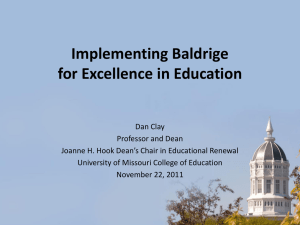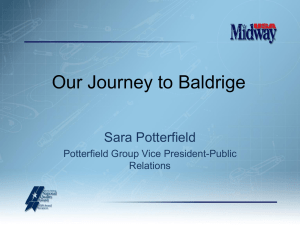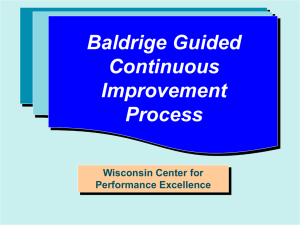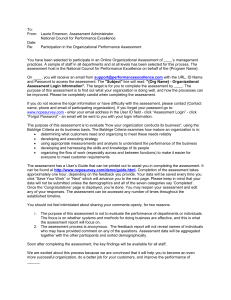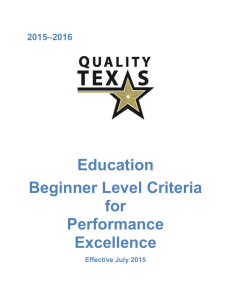BaldrigePrinciples
advertisement
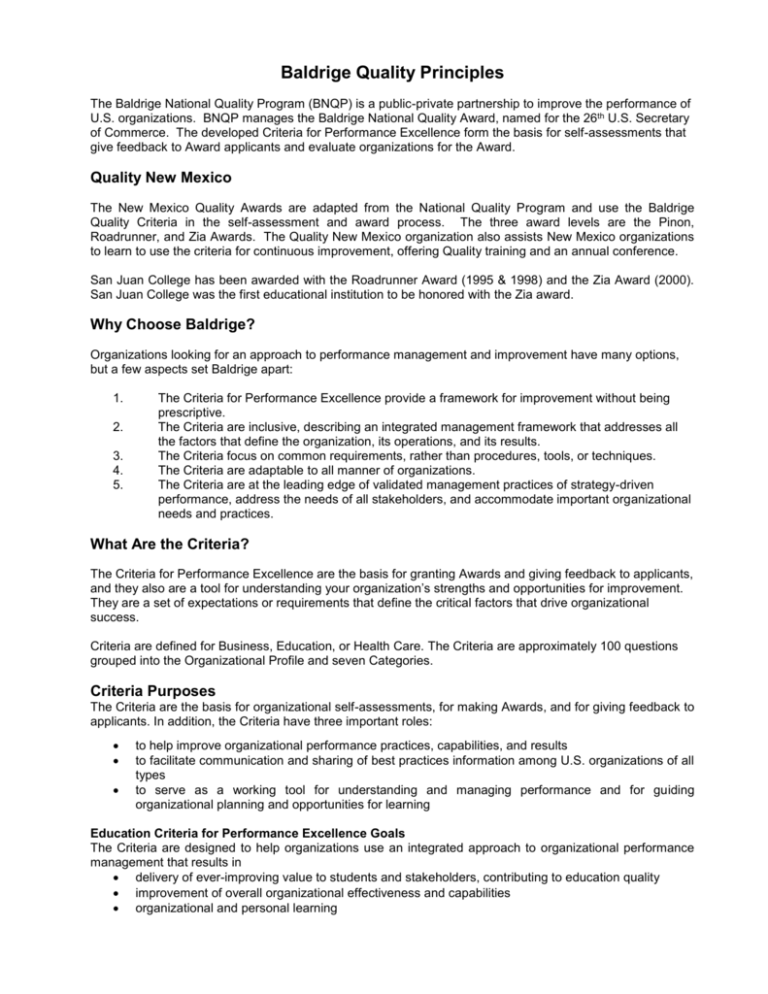
Baldrige Quality Principles The Baldrige National Quality Program (BNQP) is a public-private partnership to improve the performance of U.S. organizations. BNQP manages the Baldrige National Quality Award, named for the 26th U.S. Secretary of Commerce. The developed Criteria for Performance Excellence form the basis for self-assessments that give feedback to Award applicants and evaluate organizations for the Award. Quality New Mexico The New Mexico Quality Awards are adapted from the National Quality Program and use the Baldrige Quality Criteria in the self-assessment and award process. The three award levels are the Pinon, Roadrunner, and Zia Awards. The Quality New Mexico organization also assists New Mexico organizations to learn to use the criteria for continuous improvement, offering Quality training and an annual conference. San Juan College has been awarded with the Roadrunner Award (1995 & 1998) and the Zia Award (2000). San Juan College was the first educational institution to be honored with the Zia award. Why Choose Baldrige? Organizations looking for an approach to performance management and improvement have many options, but a few aspects set Baldrige apart: 1. 2. 3. 4. 5. The Criteria for Performance Excellence provide a framework for improvement without being prescriptive. The Criteria are inclusive, describing an integrated management framework that addresses all the factors that define the organization, its operations, and its results. The Criteria focus on common requirements, rather than procedures, tools, or techniques. The Criteria are adaptable to all manner of organizations. The Criteria are at the leading edge of validated management practices of strategy-driven performance, address the needs of all stakeholders, and accommodate important organizational needs and practices. What Are the Criteria? The Criteria for Performance Excellence are the basis for granting Awards and giving feedback to applicants, and they also are a tool for understanding your organization’s strengths and opportunities for improvement. They are a set of expectations or requirements that define the critical factors that drive organizational success. Criteria are defined for Business, Education, or Health Care. The Criteria are approximately 100 questions grouped into the Organizational Profile and seven Categories. Criteria Purposes The Criteria are the basis for organizational self-assessments, for making Awards, and for giving feedback to applicants. In addition, the Criteria have three important roles: to help improve organizational performance practices, capabilities, and results to facilitate communication and sharing of best practices information among U.S. organizations of all types to serve as a working tool for understanding and managing performance and for guiding organizational planning and opportunities for learning Education Criteria for Performance Excellence Goals The Criteria are designed to help organizations use an integrated approach to organizational performance management that results in delivery of ever-improving value to students and stakeholders, contributing to education quality improvement of overall organizational effectiveness and capabilities organizational and personal learning 2004 EDUCATION CRITERIA: CORE VALUES, CONCEPTS, AND FRAMEWORK Core Values and Concepts The Criteria are built upon the following set of interrelated Core Values and Concepts: visionary leadership learning-centered education organizational and personal learning valuing faculty, staff, and partners agility focus on the future managing for innovation management by fact social responsibility focus on results and creating value systems perspective These values and concepts, described below, are embedded beliefs and behaviors found in high-performing organizations. They are the foundation for integrating key requirements within a results-oriented framework that creates a basis for action and feedback. Visionary Leadership Your organization’s senior leaders should set directions and create a student-focused, learning-oriented climate; clear and visible values; and high expectations. The directions, values, and expectations should balance the needs of all your stakeholders. Your leaders should ensure the creation of strategies, systems, and methods for achieving excellence, stimulating innovation, and building knowledge and capabilities. The values and strategies should help guide all activities and decisions of your organization. Senior leaders should inspire and motivate your entire workforce and should encourage all faculty and staff to contribute, to develop and learn, to be innovative, and to be creative. Senior leaders should be responsible to your organization’s governance body for their actions and performance. The governance body should be responsible ultimately to all your stakeholders for the ethics, vision, actions, and performance of your organization and its senior leaders. Senior leaders should serve as role models through their ethical behavior and their personal involvement in planning, communications, coaching, development of future leaders, review of organizational performance, and faculty and staff recognition. As role models, they can reinforce ethics, values, and expectations while building leadership, commitment, and initiative throughout your organization. In addition to their important role within the organization, senior leaders have other avenues to strengthen education. Reinforcing the learning environment in the organization might require building community support and aligning community and business leaders and community services with this aim. Learning-Centered Education In order to develop the fullest potential of all students, education organizations need to afford them opportunities to pursue a variety of avenues to success. Learning-centered education supports this goal by placing the focus of education on learning and the real needs of students. Such needs derive from market and citizenship requirements. A learning-centered organization needs to fully understand these requirements and translate them into appropriate curricula and developmental experiences. For example, changes in technology and in the national and world economies have increased demands on employees to become knowledge workers and problem solvers, keeping pace with the rapid market changes. Most analysts conclude that to prepare students for this work environment, education organizations of all types need to focus more on students’ active learning and on the development of problem-solving skills. Educational offerings also need to be built around effective learning, and effective teaching needs to stress promotion of learning and achievement. Learning-centered education is a strategic concept that demands constant sensitivity to changing and emerging student, stakeholder, and market requirements and to the factors that drive student learning, satisfaction, and persistence. It demands anticipation of changes in the education market. Therefore, learning-centered education demands awareness of development in technology and competitors’ programs and offerings, as well as rapid and flexible responses to student, stakeholder, and market changes. Key characteristics of learning-centered education include the following: High developmental expectations and standards are set for all students. Faculty understand that students may learn in different ways and at different rates. Student learning rates and styles may differ over time and may vary depending on subject matter. Learning may be influenced by support, guidance, and climate factors, including factors that contribute to or impede learning. Thus, the learning centered organization needs to maintain a constant search for alternative ways to enhance learning. Also, the organization needs to develop actionable information on individual students that bears upon their learning. A primary emphasis on active learning is provided. This may require the use of a wide range of techniques, materials, and experiences to engage student interest. Techniques, materials, and experiences may be drawn from external sources such as businesses, community services, or social service organizations. Formative assessment is used to measure learning early in the learning process and to tailor learning experiences to individual needs and learning styles. Summative assessment is used to measure progress against key, relevant external standards and norms regarding what students should know and should be able to do. Students and families are assisted in using self-assessment to chart progress and to clarify goals and gaps. There is a focus on key transitions such as school-to school and school-to-work. Organizational and Personal Learning Achieving the highest levels of organizational performance requires a well-executed approach to organizational and personal learning. Organizational learning includes both continuous improvement of existing approaches and adaptation to change, leading to new goals and/or approaches. Learning needs to be embedded in the way your organization operates. This means that learning (1) is a regular part of daily work; (2) is practiced at personal, work unit, department, and organizational levels; (3) results in solving problems at their source (“root cause”); (4) is focused on building and sharing knowledge throughout your organization; and (5) is driven by opportunities to effect significant, meaningful change. Sources for learning include ideas from faculty and staff, education and learning research findings, students’ and stakeholders’ input, best practice sharing, and benchmarking. Improvement in education requires a strong emphasis on effective design of educational programs, curricula, and learning environments. The overall design should include clear learning objectives, taking into account the individual needs of students. Design must also include effective means for gauging student progress. A central requirement of effective design is the inclusion of an assessment strategy. This strategy needs to emphasize the acquisition of formative information—information that provides an early indication of whether or not learning is taking place—to minimize problems that might arise if learning barriers are not promptly identified and addressed. Faculty and staff success depends increasingly on having opportunities for personal learning and practicing new skills. Organizations invest in personal learning through education, training, and other opportunities for continuing growth. Such opportunities might include job rotation and increased pay for demonstrated knowledge and skills. Education and training programs may benefit from technologies, such as computerand Internet-based learning and satellite broadcasts. Personal learning can result in (1) more satisfied and versatile faculty and staff who stay with your organization, (2) organizational cross-functional learning, (3) building the knowledge assets of your organization, and (4) an improved environment for innovation. Thus, learning is directed not only toward better educational programs and services but also toward being more adaptive, innovative, flexible, and responsive to the needs of students, stakeholders, and the market, as well as giving your faculty and staff satisfaction and motivation to excel. Valuing Faculty, Staff, and Partners An organization’s success depends increasingly on the diverse knowledge, skills, creativity, and motivation of all its faculty, staff, and partners. Valuing faculty and staff means committing to their satisfaction, development, and well-being. Increasingly, this involves more flexible, high-performance work practices tailored to faculty and staff with diverse workplace and home life needs. For faculty, development means building not only discipline knowledge but also knowledge of student learning styles and of assessment methods. Faculty participation might include contributing to the organization’s policies and working in teams to develop and execute programs and curricula. Increasingly, participation is becoming more studentfocused and more multidisciplinary. Organization leaders should work to eliminate disincentives for groups and individuals to sustain these important, learning-focused professional development activities. For staff, development might include classroom and on-the job training, job rotation, and pay for demonstrated skills. Increasingly, training, education, development, and organizational structure need to be tailored to a more diverse workforce and to more flexible, high-performance work practices. Major challenges in the area of valuing faculty and staff include (1) demonstrating your leaders’ commitment to the success of your faculty and staff, (2) providing recognition that goes beyond the regular compensation system, (3) ensuring development and progression within your organization, (4) sharing your organization’s knowledge so your faculty and staff can better serve your students and stakeholders and contribute to achieving your strategic objectives, and (5) creating an environment that encourages creativity and innovation. Education organizations need to build internal and external partnerships to better accomplish overall goals. Internal partnerships might include cooperation among leadership, faculty, and staff, such as agreements with unions. Partnerships with faculty and staff might entail faculty and staff development, cross-training, or new organizational structures such as high-performance work teams. Internal partnerships also might involve creating network relationships among your work units to improve flexibility, responsiveness, and knowledge sharing. External partnerships might be with other schools, suppliers, businesses, business associations, and community and social service organizations—all stakeholders and potential contributors. Strategic partnerships or alliances are increasingly important kinds of external partnerships. Such partnerships might offer entry into new markets or a basis for new programs or services. Also, partnerships might permit the blending of your organization’s core competencies or leadership capabilities with the complementary strengths and capabilities of partners. Successful internal and external partnerships develop longer-term objectives, thereby creating a basis for mutual investment and respect. Partners should address the key requirements for success, means for regular communication, approaches to evaluating progress, and means for adapting to changing conditions. Agility Agility is an increasingly important measure of your organizational effectiveness. It requires a capacity for faster and more flexible response to the needs of your students and stakeholders. Many organizations are learning that an explicit focus on and measurement of response times help drive the simplification of the organizational structure and work processes. Empowered faculty and staff are vital assets in responding to today’s changing and demanding environment. All aspects of time performance are becoming increasingly important and should be among your key process measures. Other important benefits can be derived from this focus on time; time improvements often drive simultaneous improvements in organization, quality, and cost. Focus on the Future In today’s education environment, a focus on the future requires understanding the short- and longer-term factors that affect your organization and the education market. Pursuit of educational excellence requires a strong future orientation and a willingness to make long-term commitments to key stakeholders—your community, employers, faculty, and staff. Your organization’s planning should anticipate many factors, such as changes in educational requirements, instructional approaches, resource availability, student/stakeholder expectations, new partnering opportunities, faculty and staff development and hiring needs, technological developments, the evolving Internet environment, new student and market segments, demographics, community/ societal expectations, and strategic changes by comparable organizations. Strategic objectives and resource allocations need to accommodate these influences. A major longer-term investment associated with your organization’s improvement is the investment in creating and sustaining a mission-oriented assessment system focused on learning. This entails faculty education and training in assessment methods. In addition, the organization’s leaders should be familiar with research findings and practical applications of assessment methods and learning style information. A focus on the future includes developing faculty and staff, doing effective succession planning, creating opportunities for innovation, and anticipating public responsibilities. Managing for Innovation Innovation means making meaningful change to improve an organization’s programs, services, and processes and to create new value for the organization’s stakeholders. Innovation should lead your organization to new dimensions of performance. Innovation is no longer strictly the purview of research; innovation is important for providing ever-improving educational value to students and for improving all educational and operational processes. Organizations should be led and managed so that innovation becomes part of the learning culture and is integrated into daily work. Innovation builds on the accumulated knowledge of your organization and its faculty and staff. Therefore, the ability to capitalize on this knowledge is critical to managing for innovation. Management by Fact Organizations depend on the measurement and analysis of performance. Such measurements should derive from the organization’s needs and strategy, and they should provide critical data and information about key processes and results. Many types of data and information are needed for performance management. Performance measurement should focus on student learning, which requires a comprehensive and integrated fact-based system—one that includes input data, environmental data, performance data, comparative/competitive data, data on faculty and staff, cost data, and operational performance measurement. Measurement areas might include students’ backgrounds, learning styles, aspirations, academic strengths and weaknesses, educational progress, classroom and program learning, satisfaction with instruction and services, extracurricular activities, dropout/matriculation rates, and post-graduation success. Examples of appropriate data segmentation include segmentation by student learning results, student demographics, and faculty and staff groups. Analysis refers to extracting larger meaning from data and information to support evaluation, decision making, and improvement. Analysis entails using data to determine trends, projections, and cause and effect that might not otherwise be evident. Analysis supports a variety of purposes, such as planning, reviewing your overall performance, improving operations, change management, and comparing your performance with comparable organizations or with “best practices” benchmarks. A major consideration in performance improvement and change management involves the selection and use of performance measures or indicators. The measures or indicators you select should best represent the factors that lead to improved student, operational, and financial performance. A comprehensive set of measures or indicators tied to student, stakeholder, and/or organizational performance requirements represents a clear basis for aligning all processes with your organization’s goals. Through the analysis of data from your tracking processes, your measures or indicators themselves may be evaluated and changed to better support your goals. Social Responsibility An organization’s leaders should stress responsibilities to the public, ethical behavior, and the need to practice good citizenship. Leaders should be role models for your organization in focusing on ethics and protection of public health, safety, and the environment. Protection of health, safety, and the environment includes your organization’s operations. Planning should anticipate adverse impacts that might arise in facilities management, laboratory operations, and transportation. Effective planning should prevent problems, provide for a forthright response if problems occur, and make available information and support needed to maintain public awareness, safety, and confidence. Organizations should not only meet all local, state, and federal laws and regulatory requirements, but they should treat these and related requirements as opportunities for improvement “beyond mere compliance.” Organizations should stress ethical behavior in all stakeholder transactions and interactions. Highly ethical conduct should be a requirement of and should be monitored by the organization’s governance body. Practicing good citizenship refers to leadership and support—within the limits of an organization’s resources—of publicly important purposes. Such purposes might include improving education in your community, environmental excellence, resource conservation, community service, and sharing qualityrelated information. Leadership also entails influencing other organizations, private and public, to partner for these purposes. Managing social responsibility requires the use of appropriate measures and leadership responsibility for those measures. Focus on Results and Creating Value An organization’s performance measurements need to focus on key results. Results should be used to create and balance value for your students and for your key stakeholders—the community, employers, faculty and staff, suppliers and partners, and the public. By creating value for students and stakeholders, your organization contributes to improving overall education performance and builds loyalty. To meet the sometimes conflicting and changing aims that balancing value implies, organizational strategy should explicitly include key stakeholder requirements. This will help ensure that plans and actions meet differing stakeholder needs and avoid adverse impacts on any stakeholders. The use of a balanced composite of leading and lagging performance measures offers an effective means to communicate short and longer-term priorities, monitor actual performance, and provide a clear basis for improving results. Systems Perspective The Baldrige Criteria provide a systems perspective for managing your organization and its key processes to achieve results—performance excellence. The seven Baldrige Categories and the Core Values form the building blocks and the integrating mechanism for the system. However, successful management of overall performance requires organization-specific synthesis, alignment, and integration. Synthesis means looking at your organization as a whole and builds upon key educational requirements, including your strategic objectives and action plans. Alignment means using the key linkages among requirements given in the Baldrige Categories to ensure consistency of plans, processes, measures, and actions. Integration builds on alignment so that the individual components of your performance management system operate in a fully interconnected manner. These concepts are depicted in the Baldrige framework below. A systems perspective includes your senior leaders’ focus on strategic directions and on your students and stakeholders. It means that your senior leaders monitor, respond to, and manage performance based on your organizational results. A systems perspective also includes using your measures, indicators, and organizational knowledge to build your key strategies. It means linking these strategies with your key processes and aligning your resources to improve overall performance and satisfy students and stakeholders. Thus, a systems perspective means managing your whole organization, as well as its components, to achieve success. Education Criteria for Performance Excellence Framework The Core Values and Concepts are embodied in seven Categories, as follows: 1 Leadership 2 Strategic Planning 3 Student, Stakeholder, and Market Focus 4 Measurement, Analysis, and Knowledge Management 5 Faculty and Staff Focus 6 Process Management 7 Organizational Performance Results The figure above provides the framework connecting and integrating the Categories. From top to bottom, the framework has the following basic elements. Organizational Profile Your Organizational Profile (top of figure) sets the context for the way your organization operates. Your environment, key working relationships, and strategic challenges serve as an overarching guide for your organizational performance management system. System Operations The system operations are composed of the six Baldrige Categories in the center of the figure that define your operations and the results you achieve. Leadership (Category 1), Strategic Planning (Category 2), and Student, Stakeholder, and Market Focus (Category 3) represent the leadership triad. These Categories are placed together to emphasize the importance of a leadership focus on strategy and on students and stakeholders. Senior leaders set your organizational direction and seek future opportunities for your organization. Faculty and Staff Focus (Category 5), Process Management (Category 6), and Organizational Performance Results (Category 7) represent the results triad. Your organization’s faculty and staff and key processes accomplish the work of the organization that yields your performance results. All actions point toward Organizational Performance Results—a composite of student, stakeholder, budgetary, financial, and operational performance, including results related to faculty and staff, governance, and social responsibility. The horizontal arrow in the center of the framework links the leadership triad to the results triad, a linkage critical to organizational success. Furthermore, the arrow indicates the central relationship between Leadership (Category 1) and Organizational Performance Results (Category 7). The two-headed arrows indicate the importance of feedback in an effective performance management system. System Foundation Measurement, Analysis, and Knowledge Management (Category 4) are critical to the effective management of your organization and to a fact-based, knowledge-driven system for improving performance. Measurement, analysis, and knowledge management serve as a foundation for the performance management system. KEY CHARACTERISTICS OF THE EDUCATION CRITERIA 1. The Criteria focus on organizational performance results. The Criteria focus on the key areas of organizational performance given below. Organizational performance areas: 1) student learning results 2) student- and stakeholder-focused results 3) budgetary, financial, and market results 4) faculty and staff results 5) organizational effectiveness results, including key 6) internal operational performance measures 7) governance and social responsibility results The use of this composite of measures is intended to ensure that strategies are balanced—that they do not inappropriately trade off among important stakeholders, objectives, or short- and longer-term goals. 2. The Criteria are nonprescriptive and adaptable. The Criteria are made up of results-oriented requirements. However, the Criteria do not prescribe that your organization should or should not have departments for quality, planning, or other functions; how your organization should be structured; or that different units in your organization should be managed in the same way. These factors differ among organizations, and they are likely to change as needs and strategies evolve. The Criteria are non-prescriptive for the following reasons: 1) The focus is on results, not on procedures, tools, or organizational structure. Organizations are encouraged to develop and demonstrate creative, adaptive, and flexible approaches for meeting requirements. Non-prescriptive requirements are intended to foster incremental and major (“breakthrough”) improvements, as well as basic change. 2) The selection of tools, techniques, systems, and organizational structure usually depends on factors such as organization type and size, organizational relationships, your organization’s stage of development, and faculty and staff capabilities and responsibilities. 3) A focus on common requirements, rather than on common procedures, fosters understanding, communication, sharing, and alignment, while supporting innovation and diversity in approaches. 3. The Criteria support a systems perspective to maintaining organization-wide goal alignment. The systems perspective to goal alignment is embedded in the integrated structure of the Core Values and Concepts, the Organizational Profile, the Criteria, and the resultsoriented, cause-effect linkages among the Criteria Items. Alignment in the Criteria is built around connecting and reinforcing measures derived from your organization’s processes and strategy. These measures tie directly to student and stakeholder value and to overall performance. The use of measures thus channels different activities in consistent directions with less need for detailed procedures, centralized decision making, or overly complex process management. Measures thereby serve both as a communications tool and a basis for deploying consistent overall performance requirements. Such alignment ensures consistency of purpose while also supporting agility, innovation, and decentralized decision making. A systems perspective to goal alignment, particularly when strategy and goals change over time, requires dynamic linkages among Criteria Items. In the Criteria,actionoriented cycles of learning take place via feedback between processes and results. The learning cycles have four, clearly defined stages: 1) planning, including design of processes, selection of measures, and deployment of requirements 2) executing plans 3) assessing progress and capturing new knowledge, taking into account internal and external results 4) revising plans based upon assessment findings, learning, new inputs, and new requirements 4. The Criteria support goal-based diagnosis. The Criteria and the Scoring Guidelines make up a twopart diagnostic (assessment) system. The Criteria are a set of 19 performance-oriented requirements. The Scoring Guidelines spell out the assessment dimensions—Process and Results—and the key factors used to assess each dimension. An assessment thus provides a profile of strengths and opportunities for improvement relative to the 19 performanceoriented requirements. In this way, assessment leads to actions that contribute to performance improvement in all areas, as described in the shaded box above. This diagnostic assessment is a useful management tool that goes beyond most performance reviews and is applicable to a wide range of strategies and management systems. INTEGRATION OF KEY EDUCATION THEMES For the adaptation of the Business Criteria for Performance Excellence to education, several important education concepts have been given careful consideration and are addressed throughout the Education Criteria. Mission Specificity Although education organizations typically share common aims, individual organizational missions, roles, and programs vary greatly. Use of a single set of Criteria to cover all your organizational requirements means that these requirements need to be interpreted in terms of your own organizational mission. This is necessary because specific requirements and critical success factors differ from organization to organization. For this reason, effective use of the Criteria depends on putting these mission requirements into operation consistently across the seven Categories of the Criteria framework. In particular, Strategic Planning (Category 2) needs to address your key mission requirements, setting the stage for the interpretation of your other requirements. For example, results reported in Organizational Performance Results (Category 7) need to reflect results consistent with your organization’s mission and strategic objectives. The Education Criteria are most explicit in the area of student learning, as this requirement is common to all education organizations regardless of their larger missions. Despite this commonality, the focus of student learning and development depends on your organizational mission. For example, results reported by trade schools, engineering schools, and music schools would be expected to differ because they would reflect each organization’s mission. Nevertheless, all three types of organizations would be expected to show yearto-year improvements in their mission-specific results to demonstrate the effectiveness of their performance improvement efforts. Customers The Business Criteria for Performance Excellence use the generic term “customers” to describe the users of products or services. Although market success depends heavily on user preference, other stakeholders must be considered as well when setting overall organizational requirements. In the Education Criteria, the focus is on students and stakeholders, the key beneficiaries of educational programs, offerings, and services. As do businesses, education organizations must respond to a variety of requirements—all of which should be incorporated into responses to the Education Criteria. The adaptation of the Business Criteria to education includes a specific approach for defining key student requirements. This approach distinguishes between students and stakeholders for purposes of clarity and emphasis. Stakeholders include parents, employers, other schools, and communities. The requirements for current students differ from those for future students. Requirements for current students are more concrete, specific, and immediate; determining requirements for future students is part of the organization’s planning and should take into account changing student populations and changing requirements future students must be able to meet. A major challenge organizations face is “bridging” current student needs and the needs of future students. This requires an effective organizational learning and change strategy. Education organizations must also address the variety of requirements of their various stakeholders. Stakeholders’ requirements are of two types: (1) requirements directly related to your organization’s educational services and (2) requirements of the stakeholders themselves. For example, parents might request services related to their children’s educational program, such as integration of math and science curricula (type 1), and the parents might also request special meeting times with the school to accommodate their work schedules (type 2). Many of the needs of businesses and other stakeholders are actually needs that must be addressed in your organization’s educational services for students. The Education Criteria place primary emphasis on such needs because your organization’s success depends heavily on translating these needs into effective educational services and experiences. In addition, successful operation of an organization may depend on satisfying accreditation, environmental, legal, and other requirements. Thus, meaningful responses to the Criteria need to incorporate all relevant requirements that organizations must meet to be successful. Concept of Excellence The concept of excellence built into the Criteria is that of “value-added” demonstrated performance. Such performance has two manifestations: (1) year-to-year improvement in key measures and indicators of performance, especially student learning, and (2) demonstrated leadership in performance and performance improvement relative to comparable organizations and to appropriate benchmarks. This concept of excellence is used because (1) it places the major focus on teaching and learning strategies; (2) it poses similar types of challenges for all organizations regardless of resources and incoming student preparation and abilities; (3) it is most likely to stimulate learning-related research and to offer a means to disseminate the results of such research; and (4) it offers the potential to create an expanding body of knowledge of successful teaching and learning practices in the widest range of organizations. The focus on value-added contributions by your organization does not presuppose manufacturing-oriented, mechanistic, or additive models of student development. Also, the use of a value-added concept does not imply that your organization’s management system should include documented procedures or attempt to define “conformity” or “compliance.” Rather, the performance concept in the Education Criteria means that your organization should view itself as a key developmental influence on students (though not the only influence) and that your organization should seek to understand and optimize its influencing factors, guided by an effective assessment strategy. Assessment Strategy Central and crucial to the success of the concept of excellence in the Education Criteria is a well-conceived and well-executed assessment strategy. The characteristics of such a strategy should include the following: Clear ties should be established between what is assessed and your organization’s mission and objectives. This means not only what your students know but also what they are able to do. There should be a strong focus on improvement—of your students’ performance, your faculty’s capabilities, and your organization’s performance. An embedded, ongoing assessment with prompt feedback should be an integral component. The assessment also should be based on curricula, reference appropriate criteria, and address your key learning goals and your overall performance requirements. Clear guidelines should be established regarding how your assessment results will be used and how they will not be used. There should be an ongoing evaluation of your assessment system itself to improve the connection between assessment and student success. Success factors should be developed on an ongoing basis based on external requirements such as those derived from your markets and from other organizations. Primary Focus on Teaching and Learning Although the Education Criteria framework is intended to address all organizational requirements, including research and service, primary emphasis is placed on teaching and learning. This is done for three main reasons: 1) Teaching and learning are the principal goals of education organizations. Thus, sharing successful 2) teaching and learning strategies and methods would have the greatest impact on improving the nation’s education organizations. 3) Those who encouraged the creation of a Baldrige Award category for education cited improvement in teaching and learning as their primary or only rationale for such an award. 4) Only a small percentage of education organizations engage in research. Peer review systems exist to evaluate research. Funding organizations and businesses provide avenues to channel the directions of much research. Numerous excellent forums and media already exist for sharing research results. Much of the research performed in education organizations involves students as part of their own overall education. Thus, the educational role of research is incorporated in the Education Criteria as part of teaching and learning. Other important aspects of research—faculty development and student and faculty recruitment— are also addressed in the Criteria. The Education Criteria for Performance Excellence have evolved significantly over time to help education organizations address a dynamic environment, focus on strategy driven performance, and, most recently, address national concerns about governance and ethics. The Education Criteria have continually progressed toward an integrated systems perspective of overall organizational performance management.
